Edelstein-Keshet L. Mathematical Models in Biology
Подождите немного. Документ загружается.


506
Spatially
Distributed
Systems
and
Partial
Differential
Equation
Models
we
may
conclude that
the
homogeneous cell distribution
is
unstable
to
perturbations
of
the
form
(9) and
that
the
uniform
population
will
begin
to
aggregate.
11.3. INTERPRETING
THE
AGGREGATION CONDITION
We
shall
now pay
closer
attention
to
what
is
actually implied
by
inequality (16).
To
do
so, first
consider
the
effect
of
boundary conditions
on the
quantity
q.
Suppose
the
amoebae
are
confined
to a
region
with
length dimension
L;
that
is, 0 < x < L.
This
means
that equations (2a,b)
and
therefore also equations (8a,b)
are
equipped with
the
boundary conditions
As
we
have seen
in
Section
9.8
such conditions
can
only
be
satisfied
provided
functions
(9a,b)
are
chosen appropriately.
In
particular,
it is
essential that
that
is, sin qL = 0.
This
is
satisfied only
for
where
the
nonnegative integer
n is
called
the
mode. Thus inequality (16) implies that
To
satisfy
this
it is
necessary
to
have
one or
several
of the
following
conditions met:
1.
Values
of fi, D, k,
and/or
n
must
be
small.
2.
Values
of L
must
be
large.
3.
Values
of x,
~a,
and/or/must
be
large.
This means that
the
factors promoting
the
onset
of
egation (leading
to
instabil-
ity)
are as
follows:
1. Low
random motility
of the
cells
and a low
rate
of
degradation
of
cAMP.
2.
Large chemotactic sensitivity, high secretion rate
of
cAMP,
and a
high density
of
amoebae,
~a.
Indeed,
it has
been observed experimentally that
the
onset
of
Dictyostelium
ag-
gregation
is
accompanied
by an
increase
in
chemotactic sensitivity
and
cAMP pro-
duction,
so it
appears that these changes indeed bring about
the
condition
for
insta-
bility, given
by
inequality (19), that leads
to
aggregation.
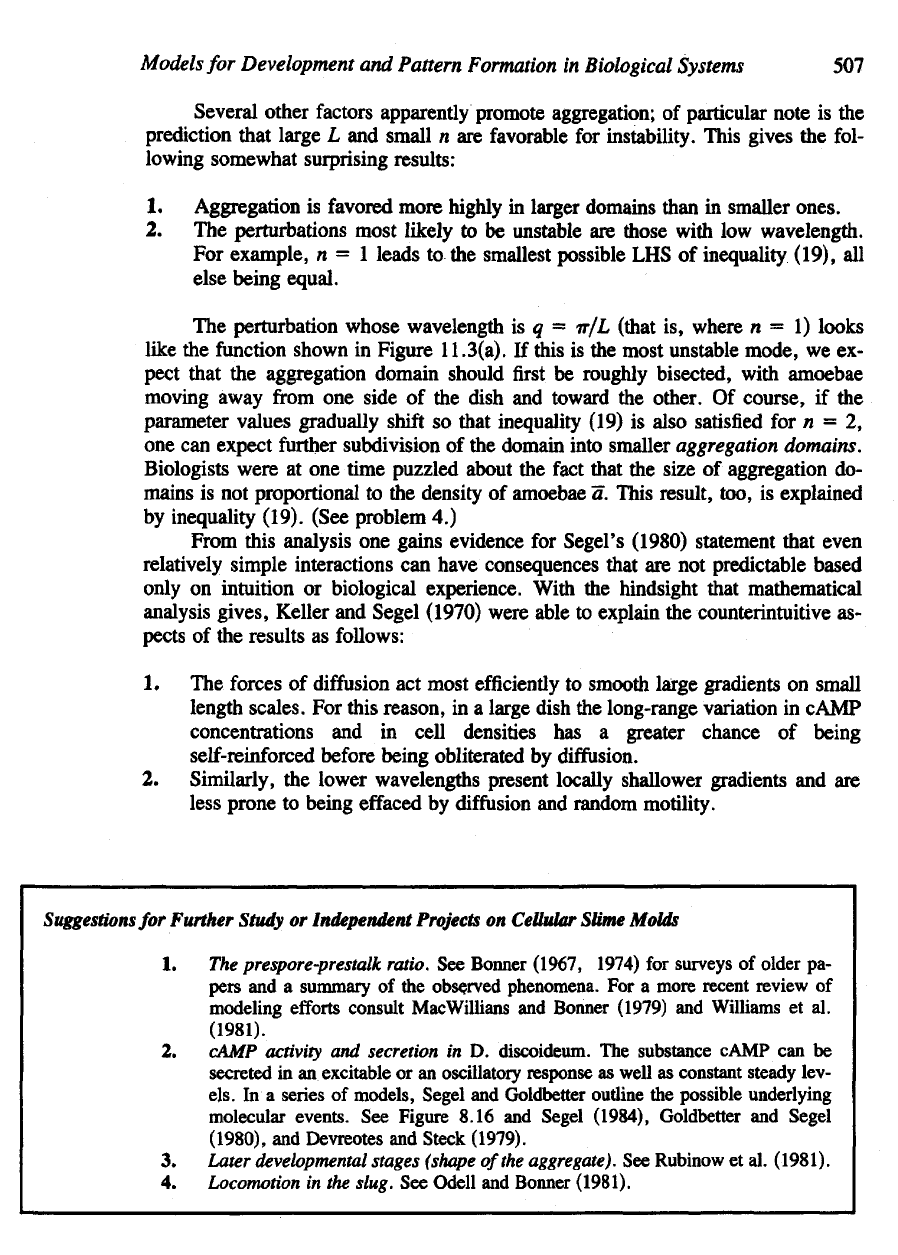
Models
for
Development
and
Pattern
Formation
in
Biological
Systems
507
Several other factors apparently promote aggregation;
of
particular note
is the
prediction that large
L and
small
n are
favorable
for
instability. This gives
the
fol-
lowing somewhat surprising
results:
1.
Aggregation
is
favored more highly
in
larger domains than
in
smaller
ones.
2. The
perturbations most likely
to be
unstable
are
those with
low
wavelength.
For
example,
n = 1
leads
to the
smallest possible
LHS of
inequality (19),
all
else
being equal.
The
perturbation whose wavelength
is q =
ir/L (that
is,
where
n = 1)
looks
like
the
function shown
in
Figure 11.3(a).
If
this
is the
most unstable mode,
we ex-
pect that
the
aggregation domain should
first be
roughly bisected, with amoebae
moving
away
from
one
side
of the
dish
and
toward
the
other.
Of
course,
if the
parameter values gradually
shift
so
that inequality (19)
is
also
satisfied
for n = 2,
one can
expect
further
subdivision
of the
domain into smaller
aggregation
domains.
Biologists were
at one time
puzzled about
the
fact
that
the
size
of
aggregation
do-
mains
is not
proportional
to the
density
of
amoebae
a.
This
result,
too,
is
explained
by
inequality (19). (See problem
4.)
From this analysis
one
gains evidence
for
Segel's (1980) statement that even
relatively simple interactions
can
have consequences that
are not
predictable based
only
on
intuition
or
biological experience. With
the
hindsight that mathematical
analysis gives, Keller
and
Segel
(1970) were able
to
explain
the
counterintuitive
as-
pects
of the
results
as
follows:
1. The
forces
of
diffusion
act
most
efficiently
to
smooth large gradients
on
small
length scales.
For
this reason,
in a
large dish
the
long-range variation
in
cAMP
concentrations
and in
cell
densities
has a
greater chance
of
being
self-reinforced before being obliterated
by
diffusion.
2.
Similarly,
the
lower wavelengths present locally shallower gradients
and are
less prone
to
being effaced
by
diffusion
and
random motility.
Suggestio
for
Further
Study
or
Independent Projects
on
Cellular Slime Molds
1. The
prespore-prestalk
ratio.
See
Bonner
(1967, 1974)
for
surveys
of
older
pa-
pers
and a
summary
of the
observed phenomena.
For a
more recent review
of
modeling
efforts
consult MacWillians
and
Bonner
(1979)
and
Williams
et al.
(1981).
2.
cAMP
activity
and
secretion
in D.
discoideum.
The
substance
cAMP
can be
secreted
in an
excitable
or an
oscillatory response
as
well
as
constant steady lev-
els.
In a
series
of
models, Segel
and
Goldbetter outline
the
possible
underlying
molecular
events.
See
Figure 8.16
and
Segel (1984), Goldbetter
and
Segel
(1980),
and
Devreotes
and
Steck (1979).
3.
Later
developmental
stages
(shape
of
the
aggregate).
See
Rubinow
et al.
(1981).
4.
Locomotion
in the
slug.
See
Odell
and
Bonner
(1981).
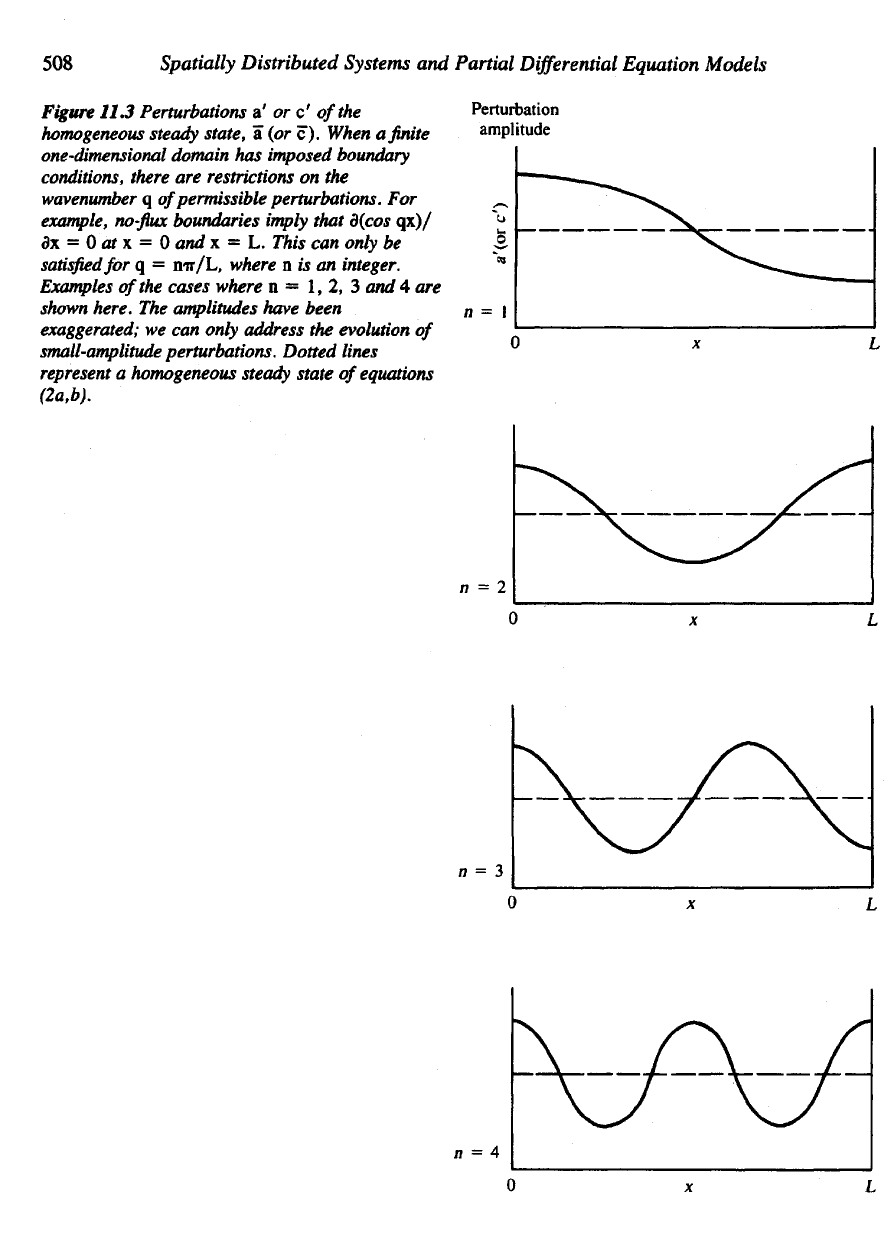
508
Spatially
Distributed
Systems
and
Partial
Differential
Equation
Models
Figure
11.3
Perturbations
a' or c'
of
the
homogeneous
steady
state,
a (or c).
When
a finite
one-dimensional
domain
has
imposed boundary
conditions,
there
are
restrictions
on the
wavenumber
q
of
permissible perturbations.
For
example,
no-flux
boundaries
imply
that d(cos
qx)/
dx
= 0 at x = 0 and x = L.
This
can
only
be
satisfied
for q =
nir/L,
where
n is an
integer.
Examples
of
the
cases where
n = 1, 2, 3 and 4 are
shown
here.
The
amplitudes have been
exaggerated;
we can
only address
the
evolution
of
small-amplitude
perturbations.
Dotted lines
represent
a
homogeneous
steady
state
of
equations
(2a,b).

Models
for
Development
and
Pattern
Formation
in
Biological
Systems
509
While
it y be
said that developmental
biologists
have
to
some extent resisted
the
intrusion
of
mathematics,
the
Keller-Segel model
has
become
a
classic
in
this
field
and
is now
frequently quoted
in
biological references. Many other aspects
of
the
differentiation
of
cellular slime molds
are
equally,
if not
more, amazing than
the
aggregation
phase.
The
topic
continues
to
attract
the
most
refined
experimental
and
theoretical
efforts.
11.4.
A
CHEMICAL BASIS
FOR
MORPHOGENESIS
Morphogenesis
describes
the
development
of
shape, pattern,
or
form
in an
organism.
The
processes
that underly morphogenesis
are
rather complex, spanning subcellular
to
multicellular levels within
the
individual. They have been studied empirically
and
theoretically
for
over
a
century. Among
the first to
devote considerable attention
to
the
topic
was
D'Arcy Thompson, whose
eclectic
and
imaginative book
On
Growth
and
Form could
be
considered
as one of the first
works
on
theoretical biology.
Thompson emphasized
the
parallels
between physical, inorganic,
and
geometric
concepts
and the
shapes
of a
variety
of
plant
and
animal structures.
Some
35
years
ago the
theoretical study
of
morphogenesis received
new im-
petus
from
a
discovery made
by a
young British mathematician, Alan Turing.
In a
startling paper dated 1952, Turing exposed
a
previously little-known physical result
that foretold
the
potential
of
diffusion
to
lead
to
"chemical
morphogenesis."
From
our
daily experience most
of us
intuitively associate
diffusion
with
a
smoothing
and
homogenizing influence that eliminates chemical gradients
and
leads
to
uniform spatial distributions.
It
comes
as
some surprise, then,
to be
told that dif-
fusion
can
have
an
opposite
effect,
engendering chemical gradients
and
fostering
nonuniform
chemical
"patterns."
Indeed, this
is
what
the
theory predicts.
The
fol-
lowing
sections
demonstrate
the
mathematical basis
for
this claim
and
outline appli-
cations
of the
idea
to
morphogenesis.
The key
elements necessary
for
chemical pattern tion are:
1. Two or
more chemical
species.
2.
Different rates
of
diffusion
for the
participants.
3.
Chemical interactions
(to be
more
fully
specified shortly).
An
appropriate combination
of
these factors
can
result
in
chemical patterns that arise
as
a
destabilization
of a
uniform chemical distribution.
Turing
recognized
the
implications
of his
result
to
biological morphogenesis.
He
suggested that during stages
in the
development
of an
organism, chemical con-
stituents generate
a
prepattern that
is
later interpreted
as a
signal
for
cellular
differ-
entiation. Since
his
paper, chemical substances that play
a
role
in
cellular
differenti-
ation have been given
the
general
label
morphogen.
The
steps
given
in
this section
are
aimed
at
exposing
the
basic idea
on
which
the
Turing
(1952)
theory
is
built.
To
deal
in
specific terms
we
consider
a set of two
chemicals that
diffuse
and
interact.
For
simplicity,
a
one-dimensional domain
is
con-
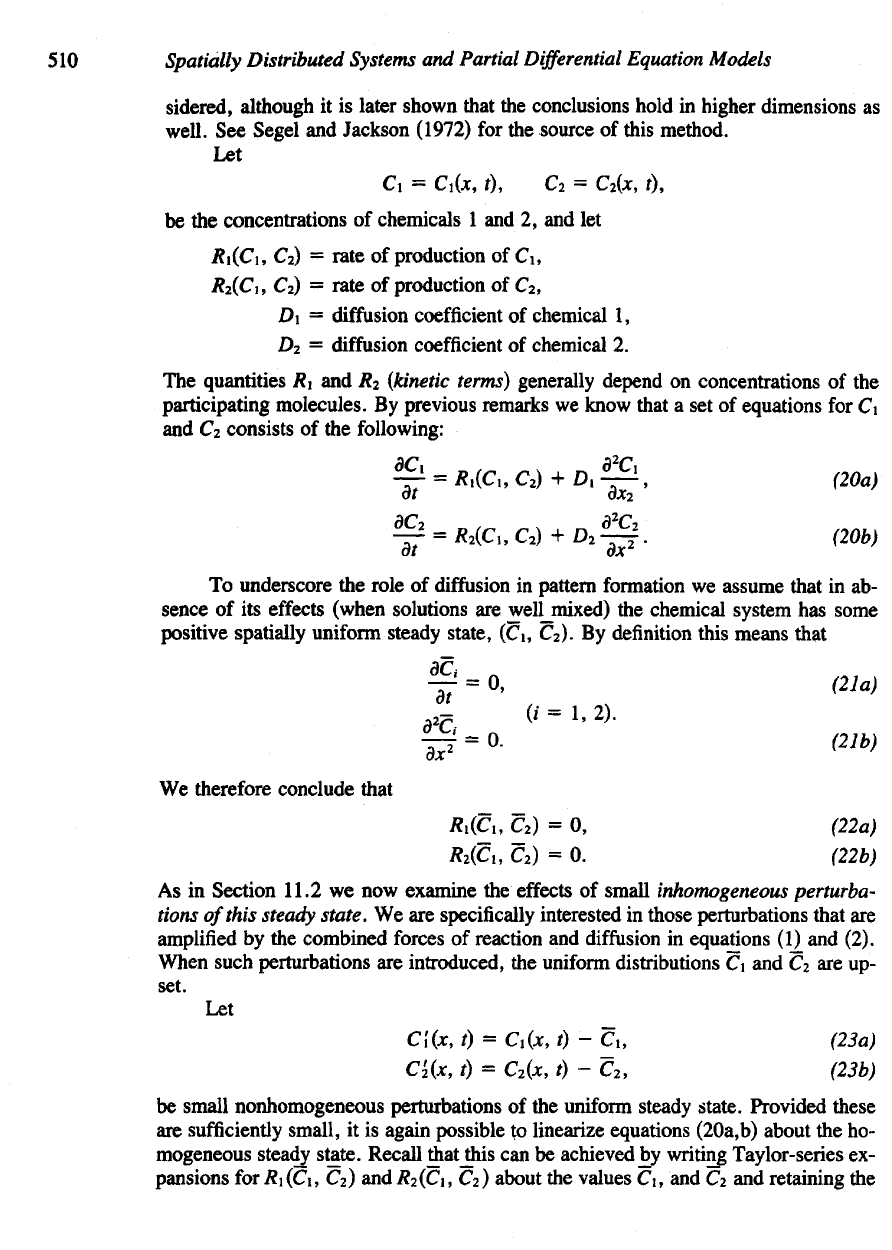
510
Spatially
Distributed
Systems
and
Partial
Differential
Equation
Models
sidered, although
it is
later shown that
the
conclusions hold
in
higher dimensions
as
well.
See
Segel
and
Jackson (1972)
for the
source
of
this method.
Let
be the
concentrations
of
chemicals
1 and 2, and let
^i(Ci,
C
2
) =
rate
of
production
of C\,
R
2
(Ci,
C
2
) =
rate
of
production
of C
2
,
Di
=
diffusion
coefficient
of
chemical
1,
Z)
2
=
diffusion
coefficient
of
chemical
2.
The
quantities
R\ and R
2
(kinetic
terms)
generally depend
on
concentrations
of the
participating molecules.
By
previous remarks
we
know that
a set of
equations
for C\
and
C
2
consists
of the
following:
To
underscore
the
role
of
diffusion
in
pattern formation
we
assume that
in ab-
sence
of its
effects
(when solutions
are
well_mixed)
the
chemical system
has
some
positive spatially uniform steady state, (Ci, C
2
).
By
definition
this means that
We
therefore conclude that
As
in
Section
11.2
we now
examine
the
effects
of
small inhomogeneous perturba-
tions
of
this
steady
state.
We are
specifically interested
in
those perturbations that
are
amplified
by the
combined forces
of
reaction
and
diffusion
in
equations
(\}_
and
(2).
When
such perturbations
are
introduced,
the
uniform
distributions
C\ and C
2
are up-
set.
be
small nonhomogeneous perturbations
of the
uniform
steady state. Provided these
are
sufficiently
small,
it is
again possible
to
linearize equations (20a,b) about
the ho-
mogeneous steady state. Recall thatjhis
can be
achieved
by
writing Taylor-series
ex-
pansions for/?i(Ci,
C
2
)
and/?
2
(Ci,
C
2
)
about
the
values
Ci, and C
2
and
retaining
the
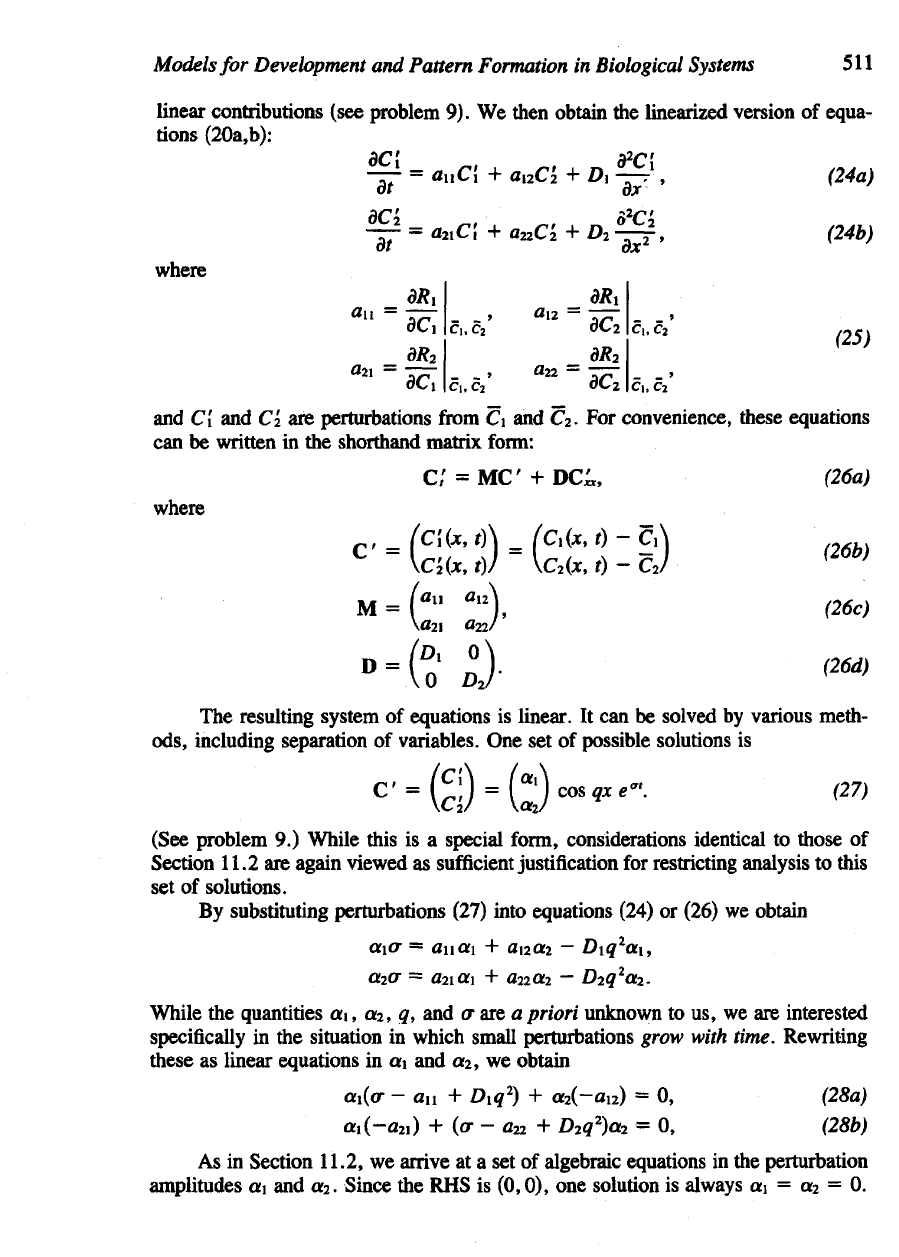
Models
for
Development
and
Pattern
Formation
in
Biological
Systems
511
linear contributions (see problem
9). We
then obtain
the
linearized version
of
equa-
tions
(20a,b):
where
and
C{ and €2 are
perturbations
from
C\ and C*. For
convenience, these equations
can be
written
in the
shorthand matrix
form:
where
The
resulting system
of
equations
is
linear.
It can be
solved
by
various meth-
ods, including separation
of
variables.
One set of
possible solutions
is
(See problem
9.)
While this
is a
special
form,
considerations identical
to
those
of
Section
11.2
are
again viewed
as
sufficient
justification
for
restricting analysis
to
this
set of
solutions.
By
substituting perturbations (27) into equations (24)
or
(26)
we
obtain
While
the
quantities
a\, a
2
, q, and o are a
priori
unknown
to us, we are
interested
specifically
in the
situation
in
which small perturbations
grow
with
time. Rewriting
these
as
linear equations
in a\ and a
2
, we
obtain
As
in
Section 11.2,
we
arrive
at a set of
algebraic equations
in the
perturbation
amplitudes
ai and
a-i. Since
the RHS is
(0,0),
one
solution
is
always
a\ = «2 = 0.
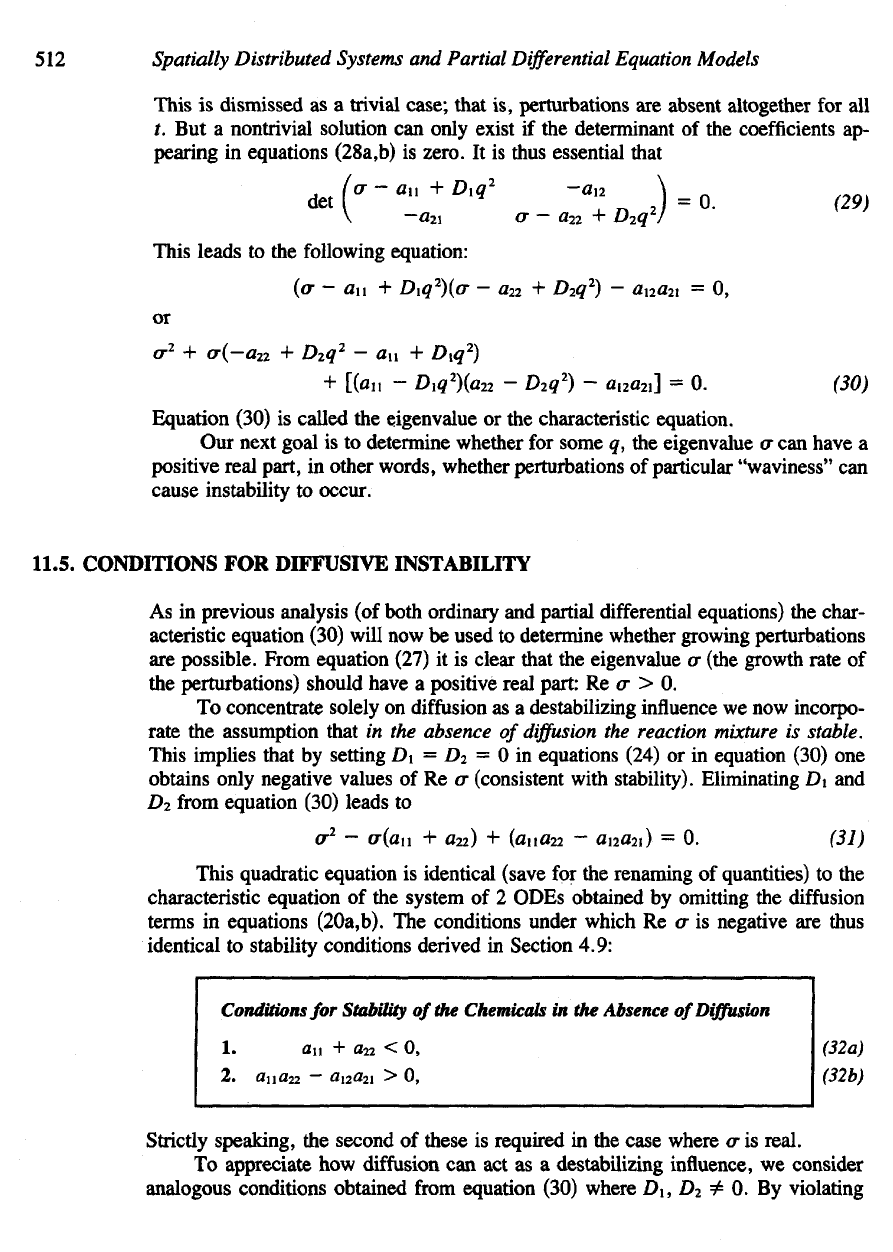
512
Spatially
Distributed
Systems
and
Partial
Differential
Equation
Models
This
is
dismissed
as a
trivial
case;
that
is,
perturbations
are
absent altogether
for all
t. But a
nontrivial solution
can
only exist
if the
determinant
of the
coefficients
ap-
pearing
in
equations (28a,b)
is
zero.
It is
thus
essential that
This
leads
to the
following equation:
Equation (30)
is
called
the
eigenvalue
or the
characteristic equation.
Our
next goal
is to
determine whether
for
some
q, the
eigenvalue
o~
can
have
a
ositive real part,
in
other words, whether perturbations
of
particular "waviness"
can
cause instability
to
occur.
or
L.5.
CONDITIONS
FOR
DIFFUSIVE INSTABILITY
As
in
previous analysis
(of
both ordinary
and
partial
differential
equations)
the
char-
acteristic
equation (30) will
now be
used
to
determine whether growing perturbations
are
possible.
From equation (27)
it is
clear that
the
eigenvalue
cr
(the growth rate
of
the
perturbations) should have
a
positive real part:
Re cr > 0.
To
concentrate solely
on
diffusion
as a
destabilizing
influence
we now
incorpo-
rate
the
assumption that
in the
absence
of
diffusion
the
reaction mixture
is
stable.
This implies that
by
setting
D\ = D
2
= 0 in
equations (24)
or in
equation (30)
one
obtains only negative values
of Re cr
(consistent
with
stability). Eliminating
D\ and
D^
from
equation (30) leads
to
This quadratic equation
is
identical (save
for the
renaming
of
quantities)
to the
characteristic equation
of the
system
of 2
ODEs obtained
by
omitting
the
diffusion
terms
in
equations (20a,b).
The
conditions under which
Re cr is
negative
are
thus
identical
to
stability conditions derived
in
Section 4.9:
Conditions
for
Stability
of the
Chemicals
in the
Absence
of
Diffusion
Strictly speaking,
the
second
of
these
is
required
in the
case where
cr is
real.
To
appreciate
how
diffusion
can act as a
destabilizing
influence,
we
consider
analogous conditions obtained
from
equation (30) where
D\, D
2
^ 0. By
violating
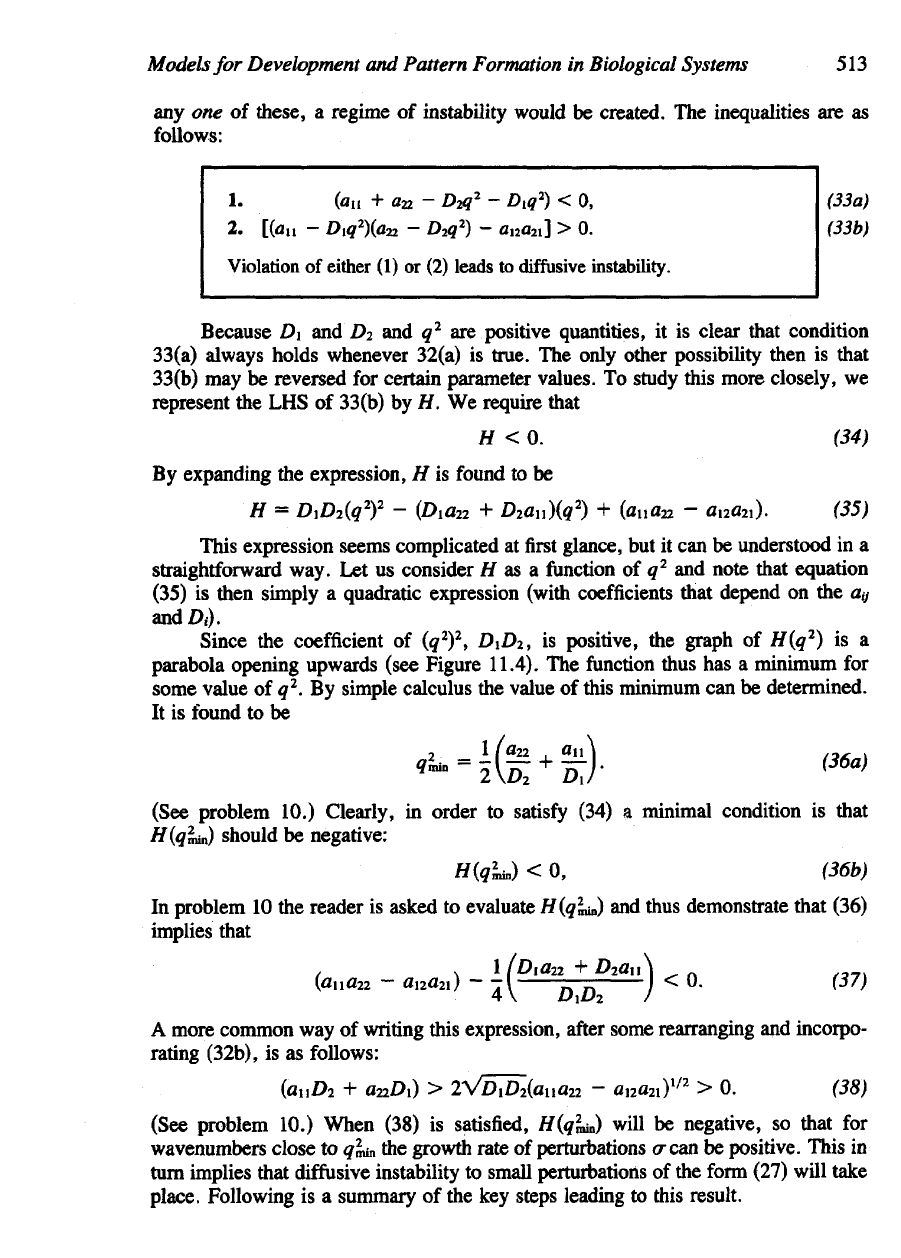
Models
for
Development
and
Pattern Formation
in
Biological
Systems
513
any
one of
these,
a
regime
of
instability would
be
created.
The
inequalities
are as
follows:
Because
D\ and D
2
and q
2
are
positive quantities,
it is
clear that condition
33(a) always holds whenever 32(a)
is
true.
The
only other possibility then
is
that
33(b)
may be
reversed
for
certain parameter values.
To
study this more
closely,
we
represent
the LHS of
33(b)
by H. We
require that
Violation
of
either
(1) or (2)
leads
to
diffusive
instability.
By
expanding
the
expression,
H is
found
to be
This expression seems complicated
at
first
glance,
but it can be
understood
in a
straightforward
way.
Let us
consider
H as a
function
of q
2
and
note that equation
(35)
is
then simply
a
quadratic expression (with coefficients that depend
on the ay
and
£>,).
Since
the
coefficient
of
(q
2
)
2
,
£>iD
2
,
is
positive,
the
graph
of
H(q
2
)
is a
parabola opening upwards (see Figure 11.4).
The
function
thus
has a
minimum
for
some value
of q
2
. By
simple calculus
the
value
of
this minimum
can be
determined.
It is
found
to be
(See problem 10.) Clearly,
in
order
to
satisfy
(34)
a
minimal condition
is
that
#(<?iiiin)
should
be
negative:
In
problem
10 the
reader
is
asked
to
evaluate //(^Ln)
and
thus
demonstrate that (36)
implies that
A
more common
way of
writing this expression,
after
some rearranging
and
incorpo-
rating
(32b),
is as
follows:
(See problem 10.) When (38)
is
satisfied,
H(ql^
will
be
negative,
so
that
for
wavenumbers
close
to q^ the
growth rate
of
perturbations 0-can
be
positive.
This
in
turn
implies that
diffusive
instability
to
small perturbations
of the
form
(27) will take
place.
Following
is a
summary
of the key
steps leading
to
this result.
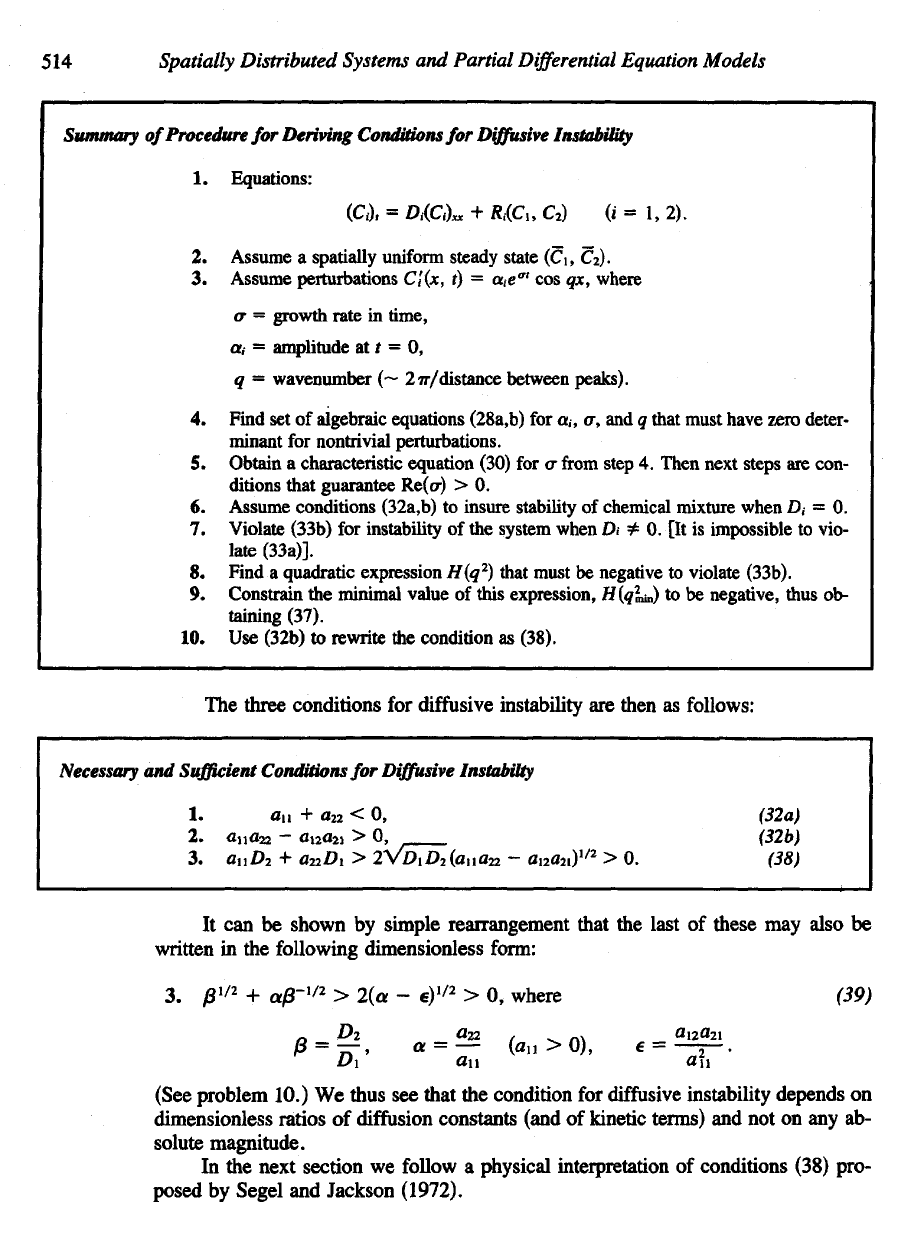
514
Spatially Distributed Systems
and
Partial
Differential
Equation Models
Summary
of
Procedure
for
Deriving
Conditions
for
Diffusive
Instability
1.
Equations:
2.
Assume
a
spatially
uniform
steady state
(d,
€2).
3.
Assume perturbations C/(x,
t) =
ate"'
cos qx,
where
(7
=
growth rate
in time,
a, =
amplitude
at / = 0,
q =
wavenumber
(~
27r/distance between peaks).
4.
Find
set of
algebraic equations (28a,b)
for a,, or, and q
that must have zero deter-
minant
for
nontrivial perturbations.
5.
Obtain
a
characteristic equation (30)
for
cr
from
step
4.
Then next steps
are
con-
ditions that guarantee
Re(cr)
> 0.
6.
Assume conditions (32a,b)
to
insure stability
of
chemical mixture when
A = 0.
7.
Violate (33b)
for
instability
of the
system when
Di & 0. [It is
impossible
to
vio-
late
(33a)].
8.
Find
a
quadratic expression H(q
2
)
that
must
be
negative
to
violate (33b).
9.
Constrain
the
minimal value
of
this expression, H(ql^)
to be
negative, thus
ob-
taining (37).
10. Use
(32b)
to
rewrite
the
condition
as
(38).
The
three
conditions
for
diffusive
instability
are
then
as
follows:
Necessary
and
Sufficient
Conditions
for
Diffusive
Instabitty
(See
problem
10.)
We
thus
see
that
the
condition
for
diffusive
instability
depends
on
dimensionless
ratios
of
diffusion
constants
(and
of
kinetic
terms)
and not on any ab-
solute
magnitude.
In
the
next
section
we
follow
a
physical
interpretation
of
conditions
(38) pro-
posed
by
Segel
and
Jackson
(1972).
It can be
shown
by
simple
rearrangement
that
the
last
of
these
may
also
be
written
in the
following
dimensionless
form:
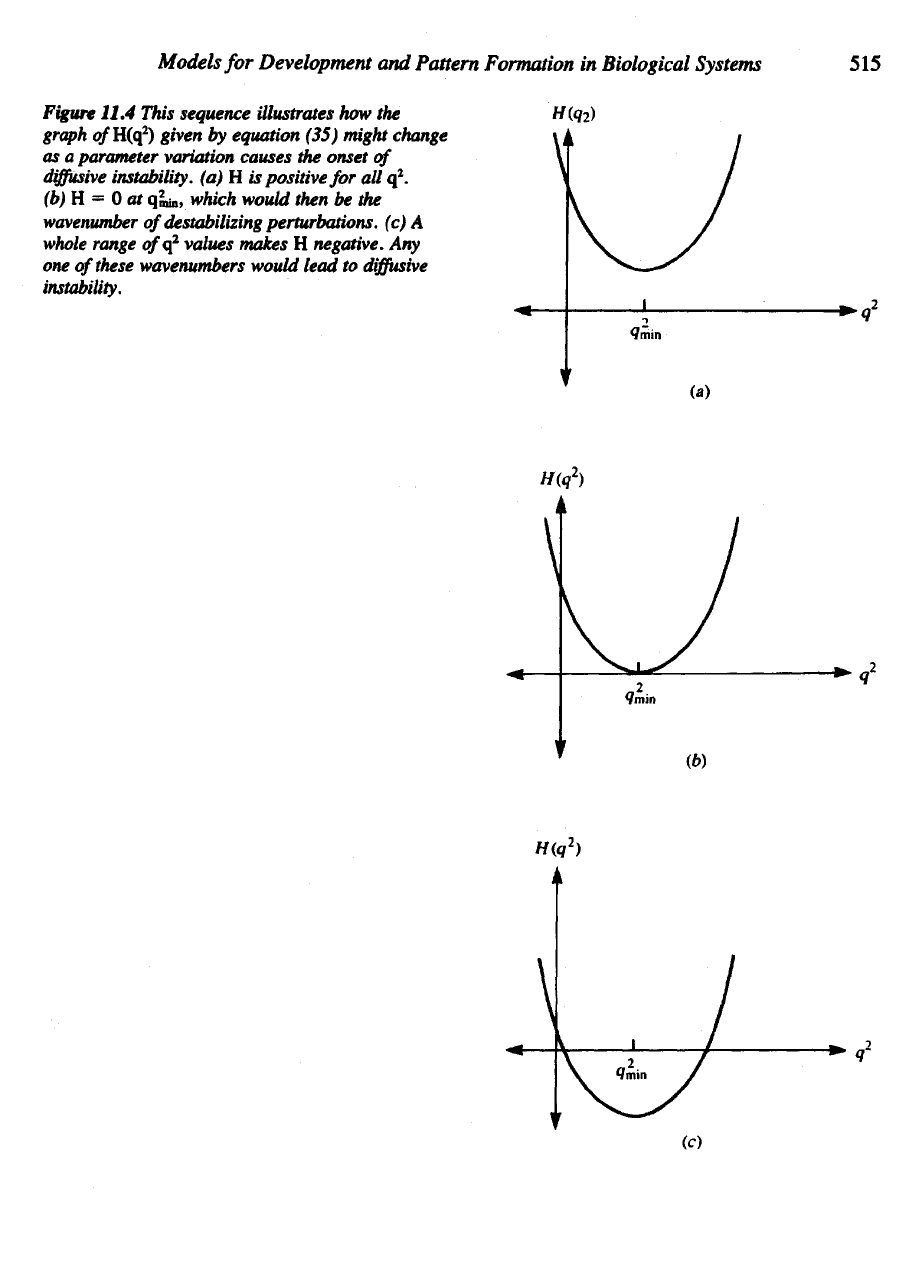
Models
for
Development
and
Pattern Formation
in
Biological Systems
515
Figure
11.4 This sequence illustrates
how the
graph
o/H(q
2
)
given
by
equation (35) might change
as a
parameter variation causes
the
onset
of
diffusive
instability,
(a) H is
positive
for all q
2
.
(b)
H = 0 at
qjrin,
which would then
be the
wavenumber
of
destabilizing perturbations,
(c) A
whole
range 0/q
2
values makes
H
negative.
Any
one
of
these wavenumbers would lead
to
diffusive
instability.
